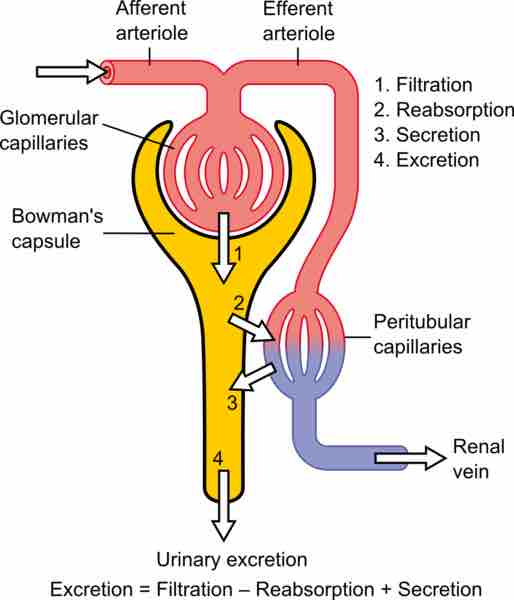Clearance
In renal physiology, clearance is a measurement of the renal excretion ability, which measures the amount of plasma from which a substance is removed from the body over an interval of time. Each substance has its own specific clearance that depends on its unique filtration characteristics.
Clearance is a function of glomerular filtration, secretion from the peritubular capillaries to the nephron, and reabsorption from the nephron back to the peritubular capillaries. Clearance can be either a constant or variable component over time, depending on the type of substance.

Physiology of the nephron
Diagram showing the basic physiologic mechanisms of the kidney.
Clearance Mechanisms
Renal clearance depends mainly on GFR, tubular absorption, and tubular secretion. If any of those variables change, the renal clearance rate of a substance will change as well. These variables alter clearance through the following rules:
- Increased GFR will increase clearance, while decreased GFR will decrease clearance.
- Increased tubular secretion will increase clearance, while decreased tubular secretion will decrease clearance. This variable is sometimes altered through changes in the expression of ATPase pumps involved in active transport.
- Increased tubular reabsorption will decrease clearance, while increased tubular reabsorption will increase clearance.
Additionally, the characteristics of the substance of interest will also determine some components of clearance. For example, certain pharmaceuticals have the tendency to bind to plasma proteins or exist unbound in plasma. Only those that are unbound will be filtered and cleared from the body. Size and molecular structure will also alter the clearance rate.
It is also important to note that renal clearance is not the only form of clearance that occurs for the substances within the plasma of the body. The other types of clearance are
- Biliary (through bile).
- Salivary.
- Pulmonary clearance (removed during alveolar gas exchange).
These types of clearance may also excrete certain molecules from the bloodstream based on their size and molecular structure; however, these forms of clearance are generally relatively minor compared to renal clearance.
These types of clearance all add up to a summation known as total body clearance, which refers to the removal of a substance from the plasma over time, incorporating all routes of removal in the body.